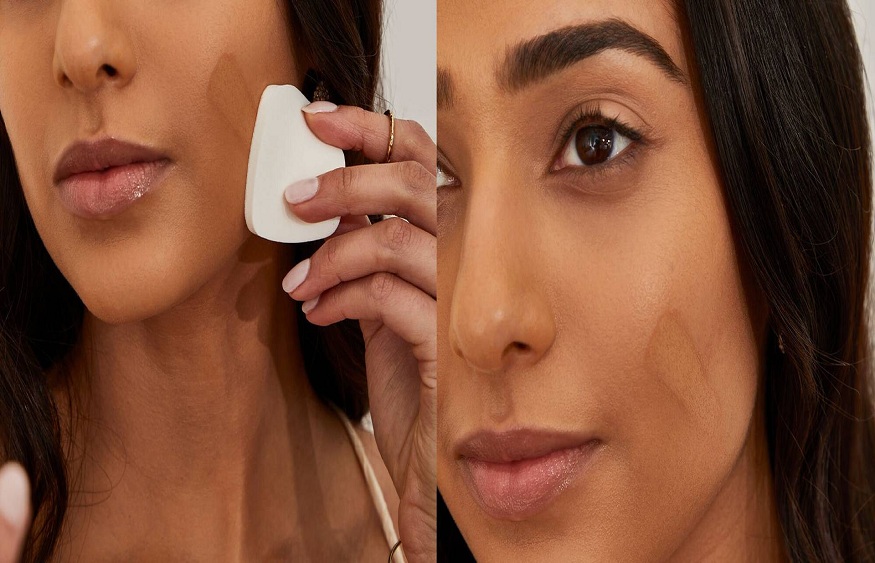Selecting the proper foundation is crucial for a picture-perfect face. Finding the right formula, shade, and finish can feel like an impossible task. In this piece, we’ll discuss what you should look for in a best foundation for glowing skin and how to locate one that works for you.
The Secret to Finding the Perfect Foundation Is Knowing Your Skin Type
Knowing your skin type is the first step in selecting the best foundation. When it comes to foundation, different skin types have distinct requirements. Some things to remember are listed below.
Use oil-free products that won’t clog your pores and create breakouts if you have oily skin. Shine can also be mitigated by choosing a matte or semi-matte finish.
If your skin is dry, you need to choose a product that can hydrate it and make it plumper. If your skin is dry or if you have fine wrinkles, you should avoid using a matte or powder makeup.
If you have combination skin, try formulas that are lightweight but can be built up to full coverage without feeling greasy. You can also apply a matte formula on your T-zone and a dewy formula on your cheeks to get a variety of looks.
Learning the Secrets of Different Types of Foundation
Several distinct varieties of underlying equations exist. Here are a few of the most typical:
Foundation in liquid form is the most widely used variety. It has a variety of textures and colours, and it’s simple to apply.
Powder: Powder foundation is an excellent choice for folks with oily skin or who want a matte look. It can be used on its own or as a second layer over liquid foundation to increase coverage.
If you have dry skin or just prefer a more hydrating foundation, cream is a great option. It’s easy to blend and has medium to full coverage.
Foundation in a stick form is ideal for on-the-go touch-ups because of its portability and ease of use. The coverage is buildable from medium to full, and it goes on smoothly.
Newer types of foundation, such as the cushion foundation, are all the rage in Asia. It’s a foundation that comes in a compact and is applied using a sponge. It’s effortless to use and leaves a finish that looks natural and light.
How to Determine Your Undertone for the Perfect Foundation Color?
It’s crucial to use a foundation that is a close match to your skin tone if you want it to look natural once applied. Knowing your own “undertone” is a crucial step in the process of finding a compatible partner. The colours that appear beneath the skin are called undertones, and they might be warm, cold, or neutral.
How to find your tone ?
Examine the veins in your wrist. If your undertones are chilly, your eyes will appear blue. Green eyes indicate a warm complexion. You have a neutral undertone if your eyes are a neutral colour, such as blue-green.
Think about how the sun affects your skin. Your skin has a warm undertone if it tans easily and you rarely burn. Those with a chilly undertone tend to be pale and susceptible to sunburn.
Consider which hues work best with your complexion. If red, orange, and yellow bring out your greatest features, you have a warm undertone. You have a cool undertone if blue, green, and purple complement your skin tone the most.
Once you’ve determined your undertone, look for foundation shades that match. Foundations with yellow, golden, or peachy undertones are the most flattering for skin tones with a warm undertone. Foundations with pink, red, or blue undertones are the most flattering on cool undertones. Foundations with either a warm or cold undertone can be worn by those with neutral undertones.
Why You Should Always Do a Patch Test Before Purchasing Foundation?
Before purchasing a foundation, it’s important to do a patch test to ensure that the shade and formula work well with your skin. How to Do a Patch Test:
Choose an inconspicuous part of your face, like the side of your jawline, and apply the foundation there.
Use a dab of foundation and blend it into the skin.
Do not examine your skin for at least half an hour after applying foundation.
Make sure the foundation’s colour and sheen are appropriate for your skin tone by testing them out in daylight.
Keep an eye out for any unwanted side effects like irritation, redness, or breakouts.
If the foundation holds up to the patch test, you can buy it with confidence and apply it all over your face.
How to Get a Flawless Face with Foundation and When Not to?
Having determined the best foundation for your skin type, you can now apply it for a natural look. Some things to remember include:
Dos:
- Use moisturiser before foundation for a flawless base.
- If you want your foundation to look natural, use a beauty sponge or a foundation brush to apply it.
- Coverage should be built up in layers, with a thin base and thicker coats added as necessary.
- Use a translucent powder to set your foundation and keep it in place all day.
Don’ts:
- Overuse of foundation can cause an unnatural, caked appearance.
- Avoid a harsh line of demarcation by blending foundation down your neck and onto your ears.
- It can make you look unnatural and unattractive to use a shade that is too light or too dark for your skin.
- If your skin is dry and flaky, foundation won’t help smooth things out and may even make things look worse.
- A flawless foundation application requires more than just knowing the dos and don’ts of applying it.
Applying a primer prior to applying foundation can help even out skin tone, minimise the appearance of pores, and increase the longevity of your foundation.
Make use of colour correctors before applying foundation to neutralise the tones of specific areas of discoloration on the skin, such as dark circles or redness.
Use foundations with varying sheens for various events: your choice of foundation sheen should be guided by both the event’s formality and your own personal taste. For an event where photographs will be taken, a matte finish may be preferable, while a dewy finish is more in keeping with a casual, everyday style.
Make sure you’re using the proper equipment; this is especially important when applying foundation. While beauty sponges are ideal for a soft, blended look, foundation brushes are better suited for more even coverage and pinpoint application.
It’s crucial to blend your foundation thoroughly to eliminate the appearance of lines and uneven texture, whether you apply it with a sponge or a brush. Applying foundation correctly requires patience and the use of circular motions to ensure a smooth finish.
To perfect your foundation game and get a flawless, natural look, try some of these additional tricks and tips. Never be afraid to try new things until you find the routine that works best for your skin type.
Conclusion
A flawless best foundation for skin is the result of careful consideration of your skin type and undertone when selecting a foundation. You can achieve a flawless, natural look with foundation by learning about the different types of formulas, performing a patch test before buying, and applying the product correctly. Keeping these suggestions in mind will put you in a position to meet your soul mate.

